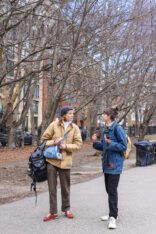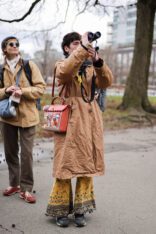
It’s 11.30 a.m. on an overcast Sunday morning and about 30 people, wrapped up in rainbow anoraks and sherbet-striped hats, are clustered by the entrance of McCarren Park. Standing in a circle, the group introduces themselves to newcomers — their names, their pronouns, and most importantly: their favorite bird.
“We’ve been into woodcocks recently,” smiles one birder, gesturing towards their partner.
“I love chickens,” says another.
The occasion is a birding and social gathering hosted by NYC Queer Birders, a birding collective launched by Anna Kremer and Hannah Kirshenbaum for LGBTQ+ folks to come together and observe the city’s birds.
While birding is an inexpensive, if not totally free, activity, birders tend to skew more educated and with a higher income, according to a study conducted by the National Survey of Fishing, Hunting, and Wildlife-Associated Recreation. In 2016, the average birder in the U.S. was a 52-year-old man white man.
Groups like NYC Queer Birders are one of a number of birding collectives launched in recent years who are working to change that, providing space for minority and marginalized groups to feel at home, together, in the outdoors.
“The groups that I’ve been a part of, it’s typically women,” says Denise Rojas, as we begin the walk around the park, ambling among the first bursts of daffodils and bluebells. “A lot of these folks are not necessarily identifying as cis-men.”

Birders bring a splash of color to New York’s parks (Photo by Arielle Domb)
Despite being the most densely populated city in the U.S., New York is located under the Atlantic Flyway, a major route for migrating birds. Over 400 species can be spotted across the city; every season brings different birds to its marshes, forests, beaches and parks.
Today, as spring approaches, Kremer and Kirshenbaum are keeping their eyes peeled for warblers — tiny, yellow birds that fly from the Boreal forest of Canada into New York City, and are sought out by the birding community (“They’re the birds that birders look for,” Kremer explains).
Nuthatches, Kinglets, Flickers, oh my!
It was a mutual love of birds that brought Kremer and Kirshenbaum together in the first place. The couple met working at a fall camp in New Hampshire, where, as Kirshenbaum put it, they would “egg each other on” with birding observations and excitement about the natural world.

Kremer and Kirshenbaum, Queer Birders NYC co-founders (Photo by Arielle Domb)
In the summer of 2019 they moved to New York together. Kremer worked at a nature school in Prospect Park; Kirshenbaum at an outdoor education center in Queens. They’d come home every night chirping about the birds they’d seen that day: White-breasted Nuthatches, Ruby-crowned Kinglets, Northern Flickers.
But finding a broader queer community in the city outside of “drinking or going out” was difficult, Kremer explains. In February 2020, a few months before the pandemic, they launched the NYC Queer Birders Instagram page, announcing their first meet-up at the ramble in Central Park.
For a while they hung around, waiting. No one came.
“We’ll get them next time,” Kirshenbaum remembers thinking.
And get them they did. These days, NYC Queer Birders has nearly 2800 followers on Instagram and Kremer and Kirshenbaum can expect up to 100 birders at their meet-ups, which are held all over the city — from Brooklyn Botanical Garden to Green-Wood Cemetery to Alley Pond Park in Queens.
One of Kremer’s favorite birds is the mockingbird, which can mimic the sounds of other species and their environments. In New York City, that often means imitating car alarms. “Even in really urban settings there’s amazing things going on,” says Kremer. “Once you open your eyes to it, you can’t not see it.”
Hidden in plain sight
McCarren Park, with its soccer fields and yuppie coffee-drinkers, is the perfect spot for it; nesting in its trees and bushes is a whole range of birds. The group’s quiet meander is interrupted when one is spotted; a birder will shout “robin!” or “Red-tailed Hawks’ nest!” and the crowd will whip out their binoculars to take a look.

Plumage, plumage everywhere (Photo by Arielle Domb)
Some birders offer up their best facts: Kremer tells me about an island in California where 14 percent of the seagulls were lesbians. People who know nothing at all about birding are welcome to join the walks too.
“For much of the early days of queer birders I didn’t even have binoculars,” says Rabin Valluri, who joined the group at the start of the pandemic. “There was no judgment or stigma from anyone in the group.”
Even within the queer community there can be varying levels of discrimination and hierarchy, says Valluri. “Birding attracts a certain personality type,” he says. “Knowing that a group of soft, outdoorsy queer people are taking a stroll through the park guarantees a safe and friendly morning of community.”
For Blair Brennan, these strolls became a welcoming refuge when she began transitioning. “Queer birding was a space where you could just walk,” she says. “There’s not a lot of pressure to talk or really try to forge friendships, but just exist in the same place as other folks.”
Around 1.p.m, the group gathers around a cherry blossom tree. Brennan pulls a bunch of blossoms towards her, smelling its sweet nectar and closing her eyes, the shadows of the tiny flowers cast across her face. Rojas points out to a teensy brown bird, hidden among the clusters of flushed pink.
“If you see a group of, like, 10 birders with big cameras and you go up and see what they’re looking at, it’s probably just a tiny, bright, beautiful bird,” Kirshenbaum says.
At its core, birding is an act of mindfulness, a process of paying attention to what the hyper-saturated world of our smartphones has trained us to ignore. It’s also a humbling act, Kirshenbaum says. The more you notice and the more you name what you see, “the more you start to learn more about what you don’t know,”
“It really changes your way of living,” Kirshenbaum says. “It adds this mystical wonder to your life.”

Photo by Arielle Domb
NYC Queer Birders post about upcoming birding meet-ups on Instagram. The next walk will take place at Marine Park on March 24 at 10 a.m.
The post Queer birding takes flight in the city appeared first on Brooklyn Magazine.

